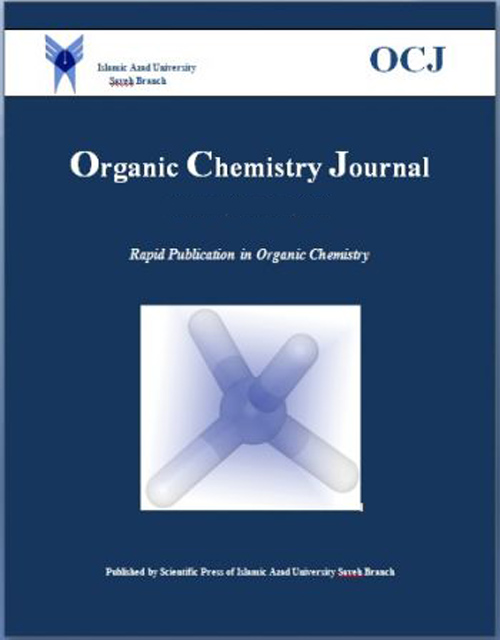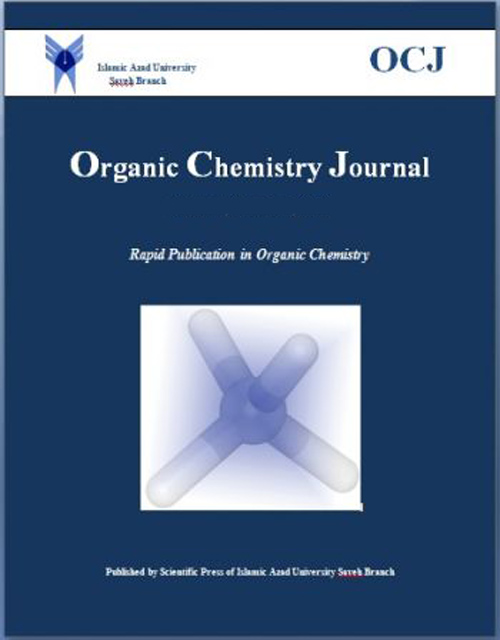فهرست مطالب

Organic Chemistry Journal
Volume:2 Issue: 1, 2011
- تاریخ انتشار: 1394/11/26
- تعداد عناوین: 8
-
Pages 1-16Continuous exposure to high-energy ultrasonic waves depolymerizes macromolecules in solutions and produces a permanent reduction in viscosity. Different factors affect the efficiency of this process. In this work ultrasonic degradation of one commercially important hydrogel based on acrylic acid and acrylamide was carried out in aqueous solution at room temperature (25°C). Also, the effect of sonication parameters (power and pulse) on the rate of degradation was investigated. A method of viscometry was used to study the degradation behavior of the hydrogel and a first order kinetic equation was employed to calculate the degradation rate constants. The experimental results indicated that the rate of ultrasonic degradation increased with increasing ultrasonic power and pulse. FT-IR and UV spectrometry measurements confirmed that the degradation proceeds by mechanical forces and also involves radical scission mechanism. Finally a mechanism was proposed according to the experimental data. The elucidated merits of the present ultrasonic process are: a) The process does not require any chemicals and additives; b) The process can be simple and rapid, which means that the process is cost effective; and c) The process will not induce large changes in the chemical structure, and in particular, the properties of hydrogel. Also, the ultrasonic process has been confirmed to be applicable for many kinds of hydrogels and gels.Keywords: Sonication, Degradation, Hydrogel, Viscosity, Kinetics
-
Pages 17-23Benzoin condensation of some aromatic aldehydes was investigated by catalytic effect of cyanide ion in alcoholic solvents. Some aldehydes including 4-methylbenzaldehyde, 4-chlorobenzaldehyde, 2furylcarbaldehyde and 4-pyridinecarbaldehyde were converted to their relative α-hydroxy ketones. 2Pyridinecarbaldehyde yielded an endiol tautomer of its relative α-hydroxy ketone, and 4nitrobenaldehyde was converted to unexpected esters in the same conditions.Keywords: Aromatic aldehydes, Benzoin, Cyanide, ?-Hydroxy ketones
-
Pages 24-30Advanced Oxidation Processes (AOPs) and chemical oxidation process (KMnO4) have been used in de-coloration of dyes in spent dyeing wastewater. In the present study, de-coloration of Indigo Carmine Dye (ICD) was carried out in a batch reactor using combination of these processes as a hybrid advanced oxidation process. The reactor used for UV/H2O2 process was equipped with a low-pressure mercury lamp. Temperature and pH values were studied as the key operating variables. The stoichiometric amount of permanganate required for 1 mol of ICD to complete colour removal was determined (1.08 mol). Also, ICD de-coloration was studied by monitoring the absorbance of dye solutions using UV/H2O2 process. The results demonstrated high rate of dye treatment using hybrid process (KMnO4/UV/H2O2) in comparison with potassium permanganate and UV/H2O2 process. The results show that dye treatment efficiency increased with increase in the amount of potassium permanganate and temperature.Keywords: Advanced Oxidation Processes, De-coloration, Dye, Wastewater treatment
-
Pages 31-35We have applied a quick and convenient method for determining folic acid (FA) excreted in mint vegetable. Sample-treatment entails SPE with Sep-Pak C18 (0.9 g) cartridge. The water-soluble vitamin were analyzed by HPLC on a Discovery C-18 150mm×4.6mm column with 0.1 mol.L-1 KH2PO4 (pH 7.0), methanol, 90:10, as mobile phase (0.7 mL min-1) in isocratic mode.Keywords: Mint analysis, High-performance liquid chromatography (HPLC), Folic acid, Solid phase extraction (SPE)
-
Pages 36-43The objective of this paper was a screening of polyphnol and flavonoid by spectrophotometer. The type of some polyphenols in Stachys inflata was determined by high performance liquid chromatography (HPLC). The methanol extract of plant material was used for HPLC analysis. The HPLC system was coupled with colorimetric detection of antioxidant activity. Additionally, the antioxidant activities were determined by ferric reducing antioxidant power (FRAP) and 1,1-diphenyl-2-picryl hydrazyl (DPPH) radical scavenging activity. The flavonoid and total phenolic contents of methanolic extract was higher than aqueous extract of Stachys inflata. A strong positive correlation of R2 = 0.90 between total phenolic content and antioxidant activity was observed in this investigation. This study indicated that Stachys inflata exhibite high antioxidant activity, flavonoid and phenolic content and can be used potentially as a readily accessible source of natural antioxidant. Antioxidant activities of polyphenols have been suggested to exert beneficial pharmacological effects on some diseases.Keywords: Phenolic compound, DPPH, Antioxidants, PJs, Folin-Ciocalteou, HPLC
-
Pages 44-49The Density Functional Theory (DFT) based method B3LYP/6-31G** were carried out to study the interaction of carbon nanostructure with glycine. Formation energy of compounds, the highest occupied molecular orbital (HOMO) and the lowest unoccupied molecular orbital (LUMO) and the HOMO-LUMO band gap were calculated. We present a theoretical study of the binding of amino acids (AA, namely glycine, Gly) to graphene (Gr), using density functional theory calculations. It is found that binding of Gly, to Gr thermodynamically favorable yet depend on the amino acid orientation and always very weak. The results presented in this work provide fundamental insights on the quantum interactions of glycine with carbon-based nanostructures and can be useful for developments in bio and nanotechnology fields.Keywords: DFT, HOMO- LUMO gap, Graphene, Glycine
-
Pages 50-54The optimization of vegetable oil leaching from spent nickel catalyst is reported in this work. Different solvents including; methyl ethyl ketone (MEK), acetone, hexane and toluene were employed. The leaching time in the range 1 to 5 h was studied. The leaching optimization shows that the use of MEK for 3 h provides the best results.
This was followed by the recovery of nickel from spent catalysts in the form of nickel sulfate. In pursue of finding a robust, inexpensive, simple and fast technique for on-line concentration measurement of nickel solution from leaching, the spectrophotometer technique was evaluated. The findings were then validated against titration method using EDTA.Keywords: Vegetable oil, Leaching, Spent nickel catalyst, Validation technique -
Pages 55-62Synthesis of various derivatives of 2H-benzo[b][1,4]oxazin-3(4H)-one is efficiently carried out starting from the corresponding o-aminophenols and 2-bromoalkanoates. Reactions take place chemoselectively at room temperature catalyzed by K2CO3 and H2O in [omim][BF4] ionic liquid. At the end of the reactions, products are separated from the mixtures by ethereal extraction and the ionic liquid is recovered and recycled into the next reactions without noticeable loss of its activity. NMR experiments show no obvious changes in the structure of the ionic liquid after several reuses.Keywords: Benzoxazinones, water, K2CO3, ionic liquids catalysis


